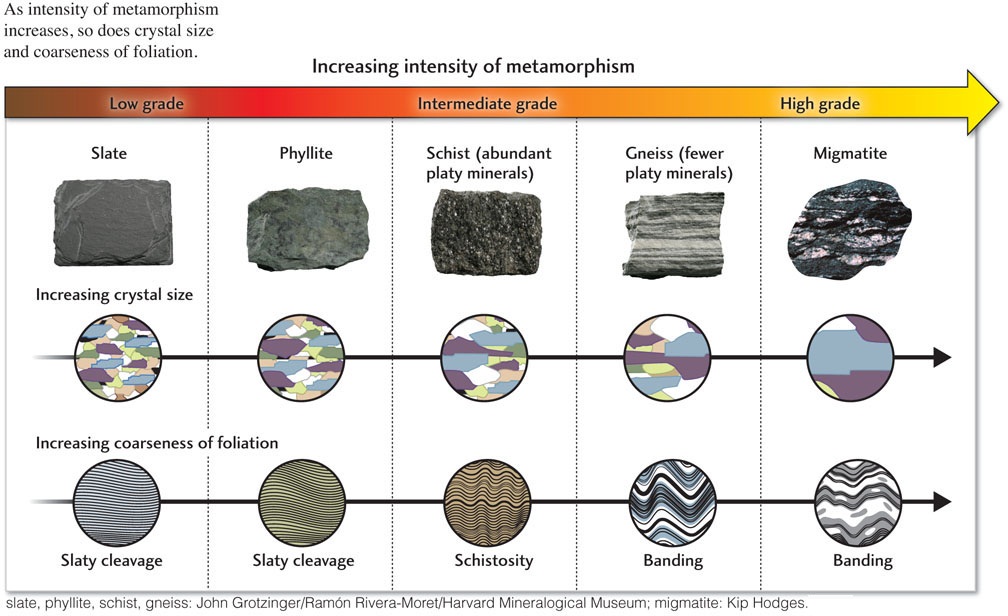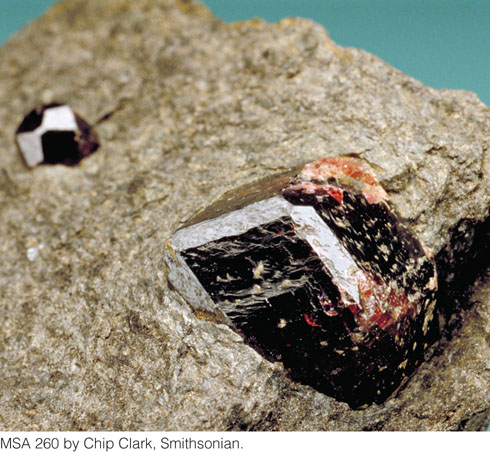Metamorphic Textures
Metamorphism imprints new textures on the rocks it alters. The texture of a metamorphic rock is determined by the sizes, shapes, and arrangement of its constituent crystals. Some metamorphic rock textures depend on the particular kinds of minerals formed under metamorphic conditions. Variation in grain size is also important. In general, grain size increases as metamorphic grade increases. Each textural variety of metamorphic rock tells us something about the metamorphic process that created it. In this section, we examine those processes, then describe two major textural classes of metamorphic rocks: foliated rocks and granoblastic rocks.
Foliation and Cleavage
The most prominent textural feature of regionally metamorphosed rocks is foliation, a set of flat or wavy parallel cleavage planes produced by deformation of igneous and sedimentary rocks under directed pressure (Figure 6.5). These foliation planes may cut through the bedding of the original sedimentary rock at any angle or be parallel to the bedding (Figure 6.5). In general, as the grade of regional metamorphism increases, foliation becomes more pronounced.

A major cause of foliation is the formation of minerals with a platy crystal habit, chiefly the micas and chlorite. The planes of all the platy crystals are aligned parallel to the foliation, an alignment called the preferred orientation of the minerals (Figure 6.5). As platy minerals crystallize, their preferred orientation is usually perpendicular to the main direction of the forces squeezing the rock during metamorphism. Crystals of preexisting minerals may contribute to the foliation by rotating until they also lie parallel to the developing foliation plane.
The most familiar form of foliation is seen in slate, a common metamorphic rock, which is easily split into thin sheets along smooth, parallel surfaces. This slaty cleavage (not to be confused with the perfect cleavage of sheet silicates such as micas) develops at small, regular intervals in the rock.
Minerals with an elongate, needlelike crystal habit also tend to assume a preferred orientation during metamorphism: these crystals, too, normally line up parallel to the foliation plane. Rocks that contain abundant amphiboles (typically, metamorphosed mafic volcanic rocks) have this kind of texture.
Foliated Rocks
The foliated rocks are classified according to four main criteria:
- 1. Metamorphic grade
- 2. Grain (crystal) size
- 3. Type of foliation
- 4. Banding
Figure 6.6 shows examples of the major types of foliated rocks. In general, foliation progresses from one texture to another with increasing metamorphic grade. In this progression, as temperature and pressure increase, a shale may metamorphose first to a slate, then to a phyllite, then to a schist, then to a gneiss, and finally to a migmatite.

156
Slate
Slates are the lowest grade of foliated rocks. These rocks are so fine-grained that their individual crystals cannot be seen easily without a microscope. They are commonly produced by the metamorphism of shales or, less frequently, of volcanic ash deposits. Slates usually range from dark gray to black, colored by small amounts of organic material originally present in the parent shale. Slate splitters learned long ago to recognize foliation planes and use them to make thick or thin slabs for roofing tiles and blackboards. Flat slabs of slate are still used for flagstone walks in places where slate is abundant.
Phyllite
Phyllites are rocks of a slightly higher grade than the slates, but are similar to them in character and origin. They tend to have a more or less glossy sheen resulting from crystals of mica and chlorite that have grown a little larger than those of slates. Phyllites, like slates, tend to split into thin sheets, but less perfectly than slates.
Schist
At low grades of metamorphism, the crystals of platy minerals are generally too small to be seen, and foliation planes are closely spaced. As rocks are subjected to higher temperatures and pressures, however, the platy crystals grow large enough to be visible to the naked eye, and the minerals tend to segregate into lighter and darker bands. This parallel arrangement of platy minerals produces the coarse, wavy foliation known as schistosity, which characterizes schists. Schists, which are intermediate-grade rocks, are among the most abundant metamorphic rock types. They contain more than 50 percent platy minerals, mainly the micas muscovite and biotite. Schists may contain thin layers of quartz, feldspar, or both, depending on the quartz content of the parent shale.
157
Gneiss
Even coarser foliation is shown by gneisses, light-colored rocks with coarse bands of light and dark minerals throughout the rock. This gneissic foliation results from the segregation of lighter-colored quartz and feldspar from darker-colored amphiboles and other mafic minerals. Gneisses are high-grade, coarse-grained metamorphic rocks in which the ratio of granular to platy minerals is higher than that in slate or schist. The result is poor foliation and thus little tendency to split. Under high pressures and temperatures, the mineral assemblages of lower-grade rocks containing micas and chlorite are transformed into new assemblages dominated by quartz and feldspars, with lesser amounts of micas and amphiboles.
Migmatite
Temperatures higher than those necessary to produce gneiss may begin to melt the country rock. In this case, as with igneous rocks (see Chapter 4), the first minerals to melt will be those with the lowest melting temperatures. Therefore, only part of the country rock melts, and the melt migrates only a short distance before solidifying again. Rocks produced in this way are badly deformed and contorted, and they are penetrated by many veins, small pods, and lenses of melted rock. The result is a mixture of igneous and metamorphic rock called migmatite. Some migmatites are mainly metamorphic, with only a small proportion of igneous material. Others have been so affected by melting that they are considered almost entirely igneous.
Granoblastic Rocks
Granoblastic rocks are nonfoliated metamorphic rocks composed mainly of crystals that grow in equant (equidimensional) shapes, such as cubes and spheres, rather than in platy or elongate shapes. These rocks result from metamorphic processes, such as contact metamorphism, in which directed pressure is absent, so foliation does not occur. Granoblastic rocks include hornfels, quartzite, marble, greenstone, amphibolite, and granulite (Figure 6.7). All granoblastic rocks except hornfels are defined by their mineralogy rather than their texture because all of them have a homogeneous granular texture.

Hornfels is a high-temperature contact metamorphic rock of uniform grain size that has undergone little or no deformation (see Figure 3.27). It is formed from fine-grained sedimentary rock and other types of rock containing an abundance of silicate minerals. Hornfels has a granular texture overall, even though it commonly contains pyroxene, which makes elongate crystals, and some micas. It is not foliated, and its platy or elongate crystals are oriented randomly.
158
Quartzites are very hard, white rocks derived from quartz-rich sandstones. Some quartzites are homogeneous, unbroken by preserved bedding or foliation (Figure 6.7a). Others contain thin bands of slate or schist, relics of former interbedded layers of clay or shale.
Marbles are the metamorphic products of heat and pressure acting on limestones and dolomites. Some white, pure marbles, such as the famous Italian Carrara marbles prized by sculptors, show a smooth, even texture of interlocked calcite crystals of uniform size. Other marbles show irregular banding or mottling from silicate and other mineral impurities in the original limestone (Figure 6.7b).
Greenstones are metamorphosed mafic volcanic rocks. Many of these low-grade metamorphic rocks form by seafloor metamorphism. Large areas of the seafloor are covered with basalts that have been slightly or extensively altered in this way at mid-ocean ridges. An abundance of chlorite gives these rocks their greenish cast.
Amphibolites are made up of amphibole and plagioclase feldspar. They are typically the product of medium- to high-grade metamorphism of mafic volcanic rocks. Foliated amphibolites can be produced by directed pressure.
Granulite, a high-grade metamorphic rock that is also referred to as granofels, has a homogeneous granular texture. It is a medium- to coarse-grained rock in which the crystals are equant and show only faint foliation at most. It is formed by the metamorphism of shale, impure sandstone, and many kinds of igneous rock.
Porphyroblasts
Newly formed metamorphic minerals may grow into large crystals surrounded by a much finer grained matrix of other minerals (Figure 6.8). These large crystals, called porphyroblasts, are found in rocks formed both by contact and by regional metamorphism. Porphyroblasts form from minerals that are stable over a broad range of pressures and temperatures. Crystals of these minerals grow large while the minerals of the matrix are being continuously recrystallized as pressures and temperatures change, so they replace parts of the matrix. Porphyroblasts vary in size, ranging from a few millimeters to several centimeters in diameter. Garnet and staurolite are two common minerals that form porphyroblasts, although many others are also found. The precise composition and distribution of porphyroblasts of these two minerals can be used to infer the pressures and temperatures that occurred during metamorphism, as we will see later in this chapter.

159
Table 6.1 summarizes the textural classes of metamorphic rocks and their main characteristics.
| Classification | Characteristics | Rock Name | Typical Parent Rock |
|---|---|---|---|
| Foliated | Distinguished by slaty cleavage, schistosity, or gneissic foliation; mineral grains show preferred orientation | Slate Phyllite Schis Gneiss |
Shale, sandstone |
| Granoblastic (nonfoliated) | Granular, characterized by coarse or fine interlocking grains; little or no preferred orientation |
Hornfels Quartzite Marble Argillite Greenstone Amphibolite Granulite |
Shale, volcanics Quartz-rich sandstone Limestone, dolomite Shale Basalt Shale, basalt Shale, basalt |
| Porphyroblastic | Large crystals set in fine-grained matrix | Slate to gneiss | Shale |